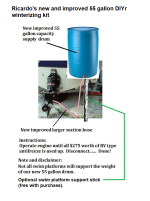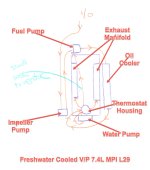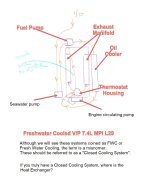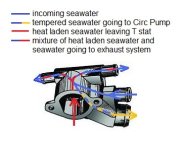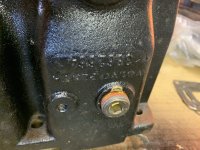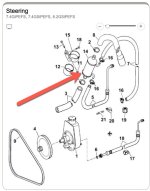Thank you or that image...it's very much the same unit I have. I swore my GM blocked Mercruisers or Crusaders (I forget which one) had a slightly different design. Maybe another set of hoses
going to the risers too?
May we assume that you meant to say "Elbows"?
Again, I just found it fascinating that the heads/blocks stay cool by the smaller hoses going out of the housing when the thermostat is open.
Those two smaller hoses DO NOT feed coolant into the cylinder block/heads.
The Circulating pump's inlet port receives seawater directly from the T-stat housing's mixing chamber.
That mixing chamber is supplied by the seawater pump.
Once the Circulating pump receives seawater, it then pushes the seawater into the cylinder block/heads.
This is now what we can refer to as "coolant".
This coolant cannot leave the cylinder block/heads (other than via the small air bleed or small by-pass porting) until the thermostat says that it can.
I guess those two hoses can equal the pressures from the water coming in from the pumps.
So when it needs to cool it obviously flows enough.
When the seawater pump is working correctly, it will supply more than enough seawater to remove heat from the engine and the exhaust system.
Due to the thermostat's open position (while it maintains normal engine operating temperature), and due to the by-pass porting within the T-Stat housing, most all seawater is by-passing engine demands, and goes right on to the exhaust system.
If this was not the case, we would not be able to keep our exhaust systems cool.
I am talking about winterizing and do use the term antifreeze as that what it's properties are.
Heck I figured you called it simply "coolant" in a Closed Cooling System!
On a Raw Water Cooled marine engine, seawater (be it ocean water, river water or lake water) is drawn in by the seawater pump.
Once this water enters the engine, it can be referred to as "coolant"..... your call on that!
But I do in fact think you are correct now that I think about cars...the coolants were always called antifreeze back in the day.
In that case, it can be referred to as Anti-Freeze or Coolant.
I'm my day job I'm a pretty good stickler or proper word choice to best explain a process/procedure or troubleshoot. So I acknowledge I'm failing here somewhat with my word choices. All very educational and I appreciate your patience and corrections.
You are very welcome.
Ironically I have read your review of that Camco system
many times in years past.
I in fact I have
always been skeptical of people getting their thermostats properly open and after watching my marine mechanic friend...I've even been skeptical of him getting it right.
If he (your marine mechanic friend) is using the Camco kit, or something similar, he may not be understanding the risks.
Please read the write-up it again.
There was good reason for me taking the time to write it and post it.
He (and his lackey worker of the season) sometimes concern me they are
getting the thermostat open properly to keep from dilution issues.
That is one of my KEY points.
The more I read the more confident I got this winterizing correct.
I thoroughly drained the block and manifolds,
That is a good start!
Don't forget the exhaust Elbows.
If you have Risers/Spacers, drain those also.
manually filled every hose and the block until the pink stuff comes out of houses and the drains.
That may offer you that "feel good feeling" if that's all you are after.
Then I closed up the blocks/manfolds and did more filling.
Drain the pink and leave it alone and dry.
I drained again to see how strong the color was...then added again and called it a day and started bugging you.
Again..... drain the pink and leave it alone and dry.
Just plain ole Air will not freeze expand and crack our expensive cast iron components.... never has and never will.
The alleged protection against rust scale (that Anti-Freeze provides), is gravely exaggerated.
Your system will develop more rust during the normal boating season than it could possibly acquire during the winter lay-up.
Again...... just plain ole Air will not freeze expand and crack our expensive cast iron components.... never has and never will.
I'm embarrassed to tell you how much pink stuff I went through this year!
I'm not surprised.
Several years ago, I put this image together.
It is a joke for those who are Hell Bent on using these winterizing kits while hoping that their thermostat opens enough to avoid dilution.
Have a laugh on me!
